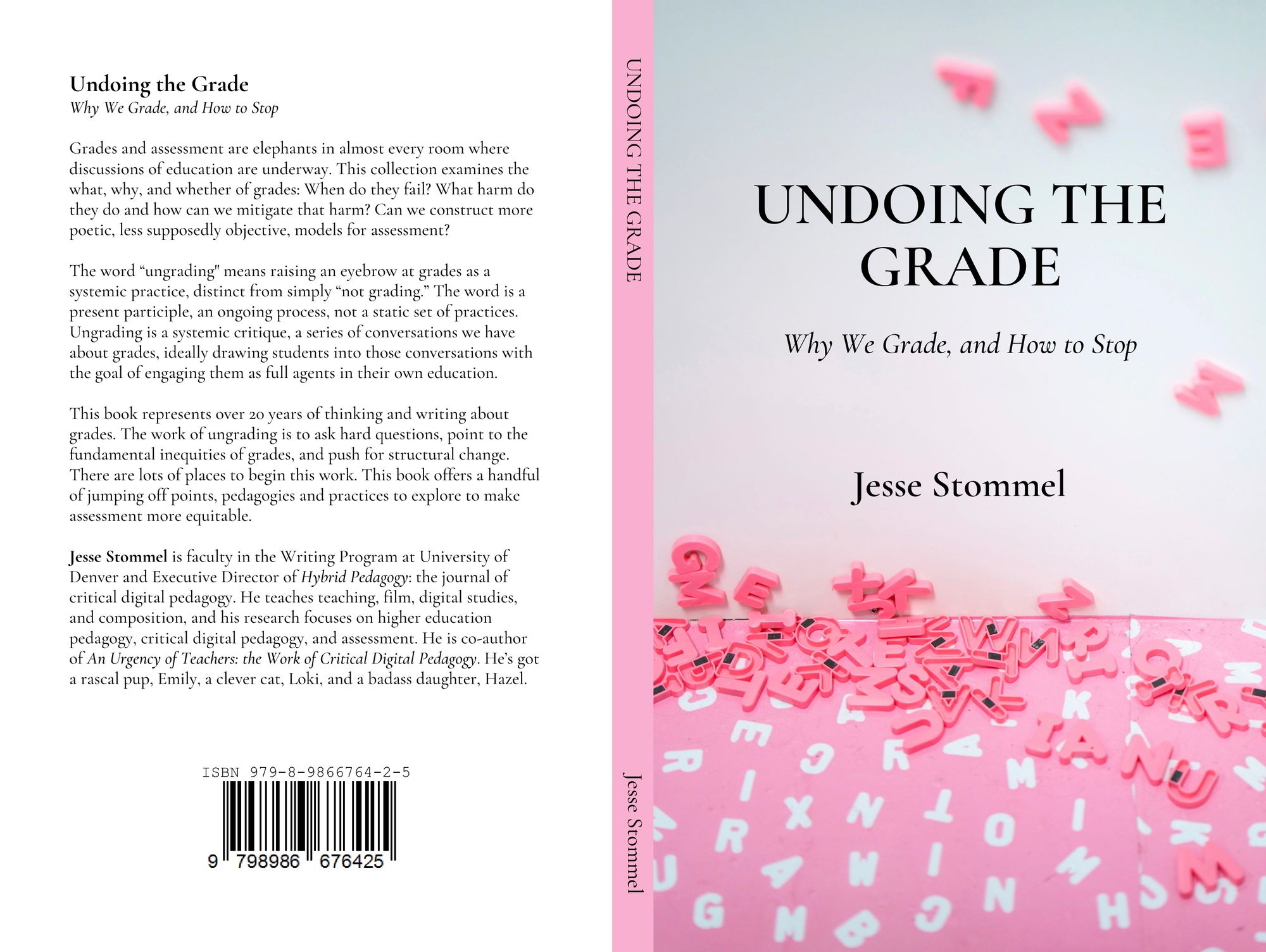How to Ungrade
This piece was revised and expanded for my new book, Undoing the Grade: Why We Grade, and How to Stop, available now in paperback and Kindle editions.
The work of teaching shouldn't be reduced to the mechanical act of grading or marking. Our talk of grading shouldn't be reduced to our complaining about the continuing necessity of it.
If you're a teacher and you hate grading, stop doing it.
"I can't think of a more meaningless, superficial, cynical way to evaluate learning."
~ Cathy N. Davidson
Across education, we've normalized absurd levels of grading, test-taking, and standardized assessment. And yet letter grades are a relatively recent phenomenon. They weren't widely used until the 1940s. In “Teaching More by Grading Less,” Jeffrey Schinske and Kimberly Tanner cite the first “official record” of a grading system from Yale in 1785. The A-F system appears to have emerged in 1898 (with the “E” not disappearing until the 1930s) and the 100-point or percentage scale became common in the early 1900s. According to Schinske and Tanner, even by 1971, only 67% of primary and secondary schools in the U.S. were using letter grades. The desire for uniformity across institutions was the primary motivator for the spread of these systems.
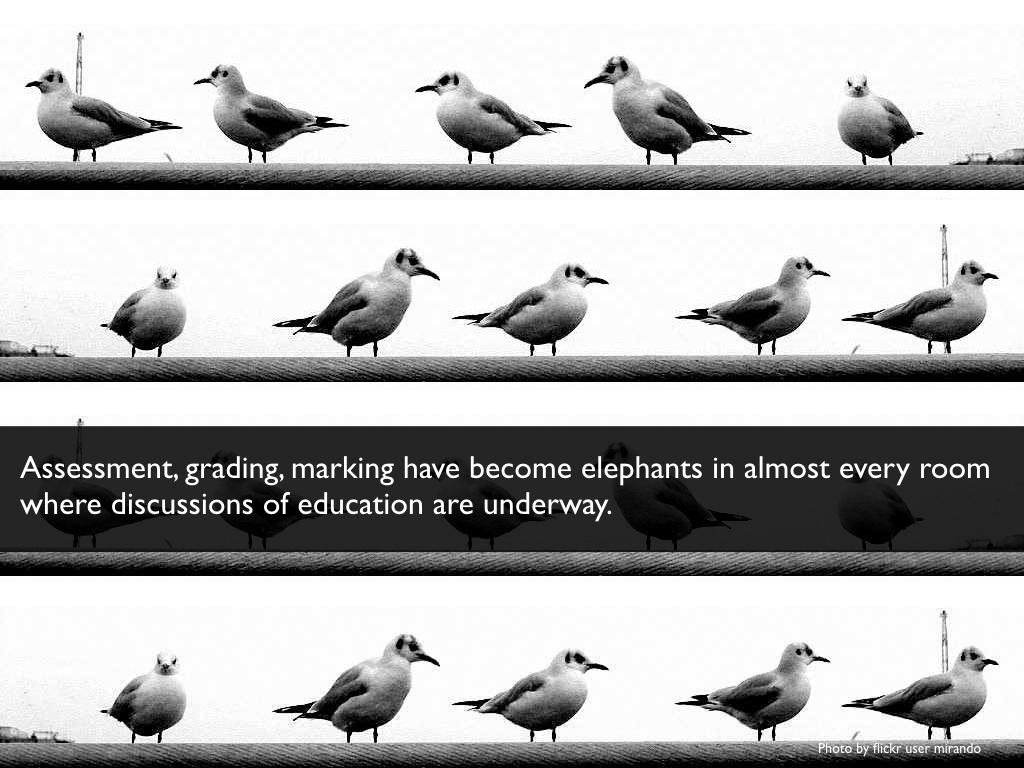
As I was preparing to write this piece, I looked through the sections on grading from a dozen or so U.S. teaching and learning centers. What I noticed across the lot of them is how their language around grading emphasizes “efficiency” (the word repeated incessantly) while reducing individual students to cogs in a machine that ultimately seems to have little to do with them. The work of grading is framed less in terms of giving feedback or encouraging learning and more as a way of ranking students against one another. Nods to “fairness” are too often made for the sake of defensibility rather than equity. What disturbs me is how effortlessly and casually this language rolls off Education's collective tongue. And I'm even more disturbed by how many otherwise productive pedagogical conversations get sidetracked by the too easily internalized ubiquity of grades.
The page from the Berkeley Graduate Division offering “Tips on Grading Efficiently” is pretty standard fare. The very first bit of advice on grading for new graduate student instructors raises more anxiety around grades than it alleviates. And at the same time, as is all too common, grading is something new teachers are encouraged to spend as little time on as possible: “Too often, time spent grading takes away from time spent doing your own coursework or research.”
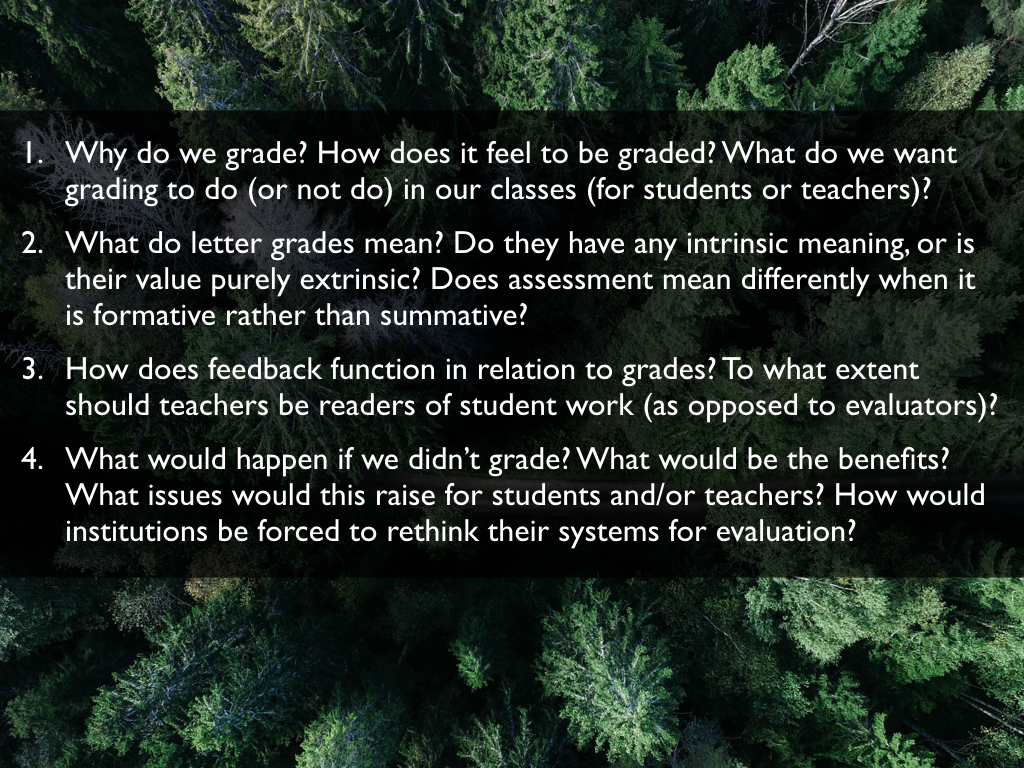
Without much critical examination, teachers accept they have to grade, students accept they have to be graded, students are made to feel like they should care a great deal about grades, and teachers are told they shouldn't spend much time thinking about the why, when, and whether of grades. Obedience to a system of crude ranking is crafted to feel altruistic, because it's supposedly fair, saves time, and helps prepare students for the horrors of the “real world.” Conscientious objection is made to seem impossible.
I've been leading workshops on grading for years, and when I talk about why I don't grade, I often hear back some version of, “but I have to grade” ... because I'm an adjunct ... because my institution requires it ... because grading is necessary in my discipline ... because wouldn't you want your heart surgeon to have been graded? The need to navigate institutional (and disciplinary) pressures is real, but I would argue teachers grade in many more situations than grading is useful and/or actually required by institutions. And, as I've said before, I care less that my doctors are graded and more that they've read all the books of Virginia Woolf or Octavia Butler, because critical thinking is what will help them save my life when they encounter a situation they've never encountered before.
Peter Elbow writes in “Ranking, Evaluating, Liking: Sorting Out Three Forms of Judgement,” "Let's do as little ranking and grading as we can. They are never fair and they undermine learning and teaching." I believe pedagogy is personal and idiosyncratic. My approach won't necessarily work in each classroom, at every institution, for all teachers, with every group of students. My hope with this and my previous posts about grading is to challenge stock assumptions, describe what has worked for me, and explore alternatives that might just work for others.
How I Don't Grade
I haven't put grades on student work since I started teaching as instructor of record in 2001. I have not felt I could be fully out about my approach to grading at every institution where I've worked. When I was a “road warrior” adjunct, teaching up to 9 courses at 4 institutions, how I talked about my pedagogy was different from one institution to the next. I had to balance my own approach with the specific requirements at each institution. But I can also say that none of the institutions where I've worked (including R1s, community colleges, liberal arts colleges) has entirely dictated how I had to approach assessment—at every single one there was sufficient wiggle room for experimentation.
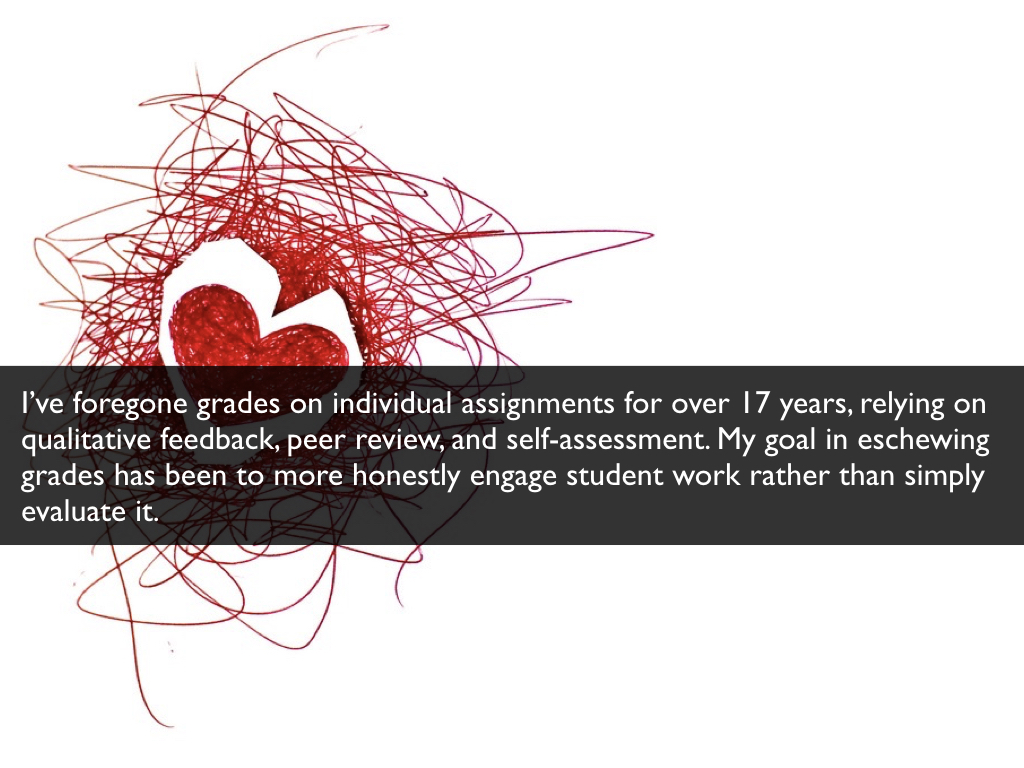
My specific approach has evolved over 17 years. Currently, I have students write self-reflections 2 - 3 times throughout the term. The first of these is usually more directed (with specific questions) than the last (which opens into something more like an essay). My goal is to help students develop their ability to do this kind of metacognitive work. Self-evaluation and metacognition are not easy, even for me, so I give students space to figure out how to do this work as they go.
I often get asked if (and how) I deal with student anxiety. Of course, being asked to do this work is a challenge. For as much anxiety as grades can also create, being graded is something most of us find comfortable. Students are increasingly conditioned to work within a system that emphasizes objective measures of performance, ranking, and quantitative marks. It's important to acknowledge that these systems have been (in some cases intentionally) crafted to privilege certain kinds of students. It's also important to acknowledge that, in lieu of these systems, there are still tacit expectations that also favor already privileged students. Students who are female, black, brown, indigenous, disabled, neurodivergent, queer, etc. face overt and systemic oppression whether expectations are explicit or implicit. Soraya Chemaly writes in “All Teachers Should Be Trained To Overcome Their Hidden Biases,” “Training teachers to understand bias will not eliminate it, but it could create an institutional environment in which it is clear that understanding bias and its effects is critically important.”
It's also important that teachers (and institutions) open these pedagogical conversations to students. And that whether we're grading or not grading, we think critically (and talk openly with students) about our approach, assumptions, tacit expectations, actual expectations, etc. We don't prepare students for a world of potential oppression by oppressing them.
Over many years, I've found that not grading begins a set of necessary conversations among my colleagues, between me and students, and among students in my classes. What students write to me in self-reflections and self-evaluations is profoundly different from the kinds of interactions we would have in a purely transactional system. Their self-evaluations (which I sometimes call “process letters”), and my responses to them, become a space of dialogue, not just about the course, but about their learning and about how learning happens. Not every interaction rises to that level but many do. What happens with almost every single student is that any assumption I might make about them is squashed by what they write about themselves and their work. My view of students as complex and deeply committed to their education is fueled by the thousands of self-reflection letters I've read throughout my career.
At the end of the term, every institution where I've worked has required me to issue a final grade for students. So, I ask the students to grade themselves. I wish I didn't have to do this. I wish the conversation I had with students could focus purely on authentic assessment, process, and formative feedback. But I have found that asking students to give themselves a grade also makes the why and how of grades a valuable subject of the conversations we have—valuable because they will go on to be graded in other courses and thinking critically about how and why grading happens helps that become more productive for them.
I'm frequently asked what I do when I disagree with the grade a student gives themselves. I don't intend my answer to be flip, but I say some version of, “it isn't really my problem.” If I'm going to give the responsibility of grading over to students, I have to let go of my attachment to the accuracy of that process. Instead, I give feedback, and the need for objectivity or accuracy gives way to a dialogue—one that is necessarily emergent and subjective. I do make clear on the syllabus (and in class) that “I reserve the right to change grades as appropriate.” But I do this only very rarely, and I usually have to raise grades. The most common change I make is from an A- to an A for students who offer no good reason other than modesty for giving themselves the A- grade. (I have observed a distinct gender imbalance in this, with women students much more likely to give themselves an A-.) Ultimately, students get the full range of grades in my classes.
My favorite bit of feedback I've ever received from a student was that my course was “one of the hardest they'd taken, but it was an easy A.” Hard, I think, because they were challenged in ways they wouldn't have otherwise been with “clear” guidelines and an objective rubric; easy, because “where they stood” in the course never felt arbitrary or mysterious.
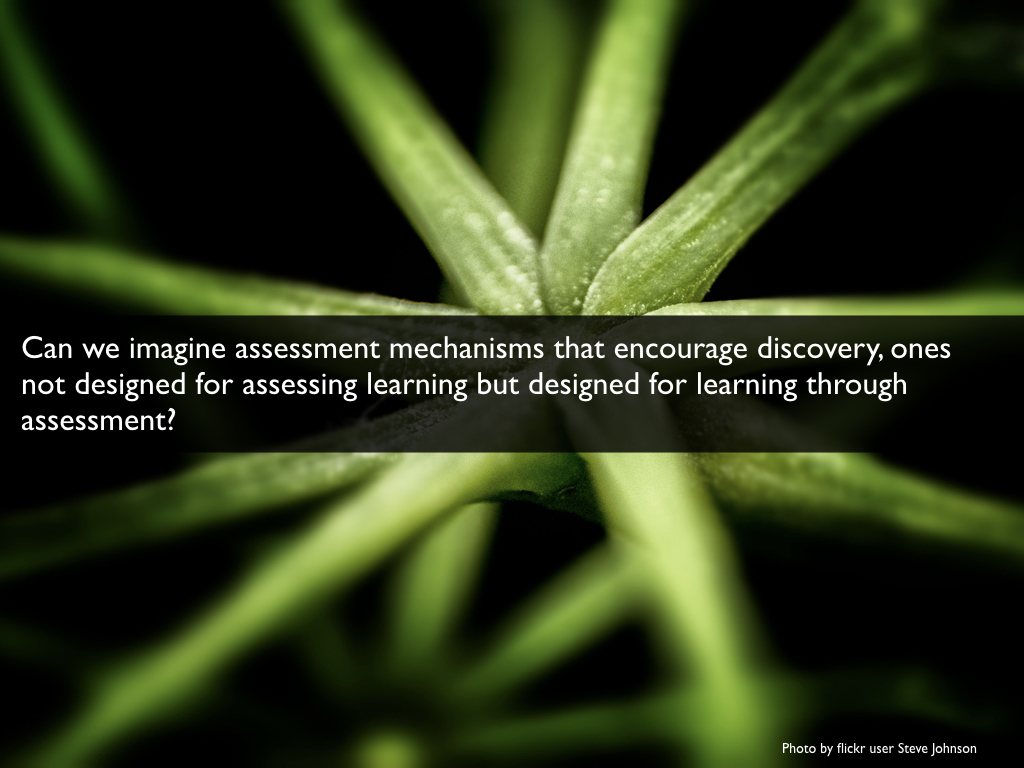
Alternate Approaches to Assessment
As I've said, there is no single approach that will work for every teacher, with every student, or at every institution. I find that ungrading works better when a teacher feels they can fully own their pedagogical approach (which requires administrators and institutions to defend the academic freedom of teachers, especially adjuncts). There are lots of different possible paths toward ungrading, and smaller experiments can be just as fruitful as larger ones.
Grade Free Zones
Sometimes, it's hard to imagine diving right into the deep end of ungrading, so try having the first 1/3 of the term be ungraded, a sandbox for students to experiment inside before moving on to the more formal activities of a course. Or decide to grade only a few major assignments.
Self-assessment
I've already talked at length about how I use self-assessment. What I'll add is that this work is both part of my approach to the problem of grades and also an end goal in and of itself. Ann Berthoff writes in “Dialectical Notebooks and the Audit of Meaning,” “Learning to look carefully, to see what you're looking at, is perenially acclaimed as the essential skill for both artist and scientist.” Metacognition is a practical skill that cuts across disciplines.
Process Letters
If you're only grading a few assignments, you may not feel like you have enough information to determine a final grade at the end of a course. I have students write process letters, describing their learning and how their work evolves over the term. This can be text, including (or linking to) representative examples of work they don't otherwise turn in. You might also ask students to take pictures of their work as it evolves, add voiceover to a screencast, or I've had students shoot video for a film documenting their learning (a sort of behind the scenes reel for the class).
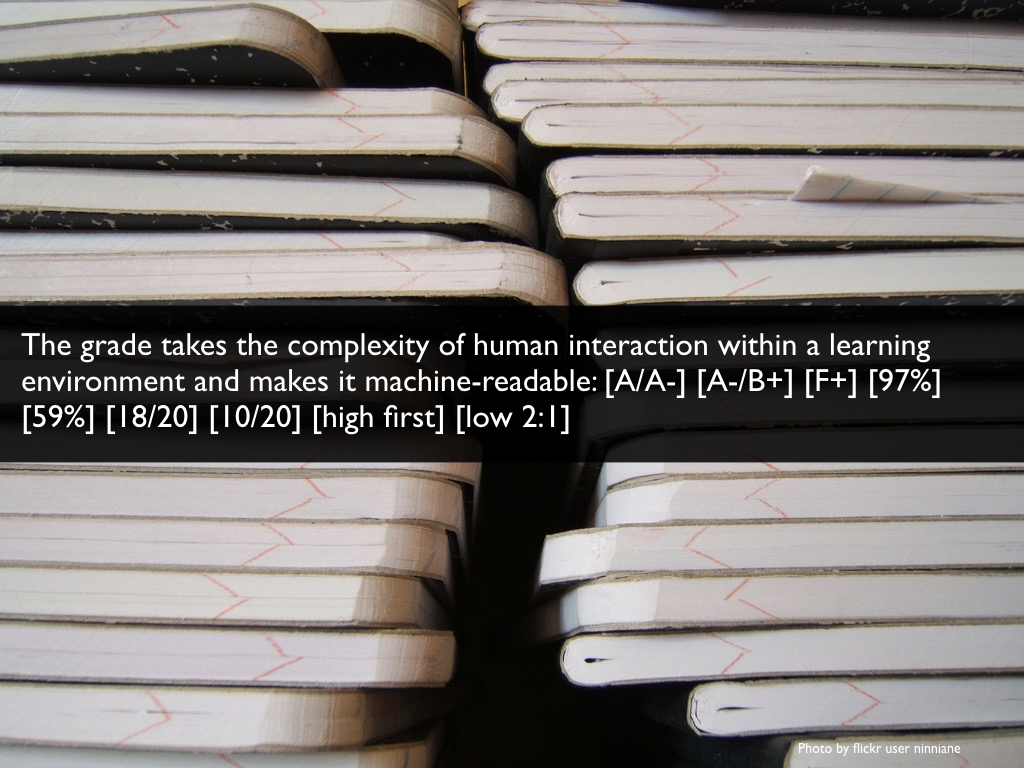
Minimal grading
In “Grading Student Writing: Making it Simpler, Fairer, Clearer,” Peter Elbow describes what he calls “minimal grading,” using a scale with only one, two, or three levels instead of giving students (admittedly bizarre) grades like 97%, 18/20, or A-/B+. Scales like these with too many gradations make it difficult for teachers to determine grades and even more difficult for students to interpret them. Elbow recommends scales with fewer gradations: [one] turned in, [two] pass/fail, [three] strong/satisfactory/weak. He also describes a “zero scale,” in which some work is assigned but not collected at all. This frees the teacher from feeling they have to respond to, evaluate, or even read every bit of work students do. And this last, moving away from student work as a thing to be “collected,” might actually prove best at creating intrinsic motivation to do the work of a course.
Authentic Assessment
In my film courses, I often ask students to organize a film festival or premiere in order to share their work for the class. These usually include talk-backs with the audience. Increasingly, I don't ask students to turn any assignments into me (aside from their self-reflections). The community of the class (including me
but not just me) becomes their audience. In a service learning course, this community expands even further beyond the boundaries of the class. In short, how can we create reasons more meaningful than points for students to do the work of a course?
Contract grading
Grading contracts convey expectations about what is required for each potential grade. In “A Grade-less Writing Course that Focuses on Labor and Assessing,” Asao B. Inoue argues for “calculating course grades by labor completed and [dispensing] almost completely with judgments of quality.” Students work toward the grade they want to achieve, and goal posts don't unexpectedly shift. These contracts can also be negotiated with the class. Either way, contract grading pushes against the relegating of people into categories, “A student,” “B student,” by keeping the focus on the work rather than the student. They can be humane in a way standardized teacher-centered rubrics usually are not. Contracts run the risk of centering grades even more than traditional grading, but at their best, the negotiating around the contract becomes a way for a group of students to collectively worry the edges of grading as a system.
Portfolios
Increasingly, many corporate e-portfolio platforms are walled gardens, giving students a regimented way of gathering together their work for the purposes of assessment. I prefer more authentic portfolios that have use value beyond the needs of individual, course, programatic, or institutional assessment. University of Mary Washington's Domain of One's Own project offers a space for students to do this kind of work, choosing a domain name, carving out space for themselves on the Web, and crafting a digital identity that exists outside (but also in conversation with) their coursework. It's a metacognitive space, but also one with immediate practical value (as a way to share their work with potential collaborators, employers, grad. schools, etc.).
Peer-Assessment
Peer-assessment can be formal (having students evaluate each other's work) or informal (just having students actively engage with one another's work). It can be particularly useful when having students work in large groups. I frequently have students work on projects that have an entire class (of 25 or more) collaborating. When I do this, I ask every student to write a process letter that addresses their own contributions as well as the functionality and dynamic of the team they're working with. With large group projects, it's hard for me to see what and how each student contributes, but these letters help me get a view into a process I might not otherwise be able to see. If it's a project students work on across the entire term, doing multiple process letters also allows me to get the information I need to step in and help when and where I'm needed.
Student-made Rubrics
I'm really not a fan of rubrics. Alfie Kohn, in “The Trouble with Rubrics,” describes them as an “attempt to deny the subjectivity of human judgment.” Rubrics are often recommended as a way to make standards for evaluation transparent, but for me, a 5x5 grid filled with copious text is bewildering and inscrutable. Rubrics have never helped me make sense of grading or being graded. Peter Elbow encourages making rubrics plainer and more direct, a 3x3 or smaller grid. The rubrics I find most exciting are ones crafted by students—so that the making of the rubric becomes an act of learning itself rather than a mechanism (or set of assumptions) created entirely in advance of students arriving to a course.
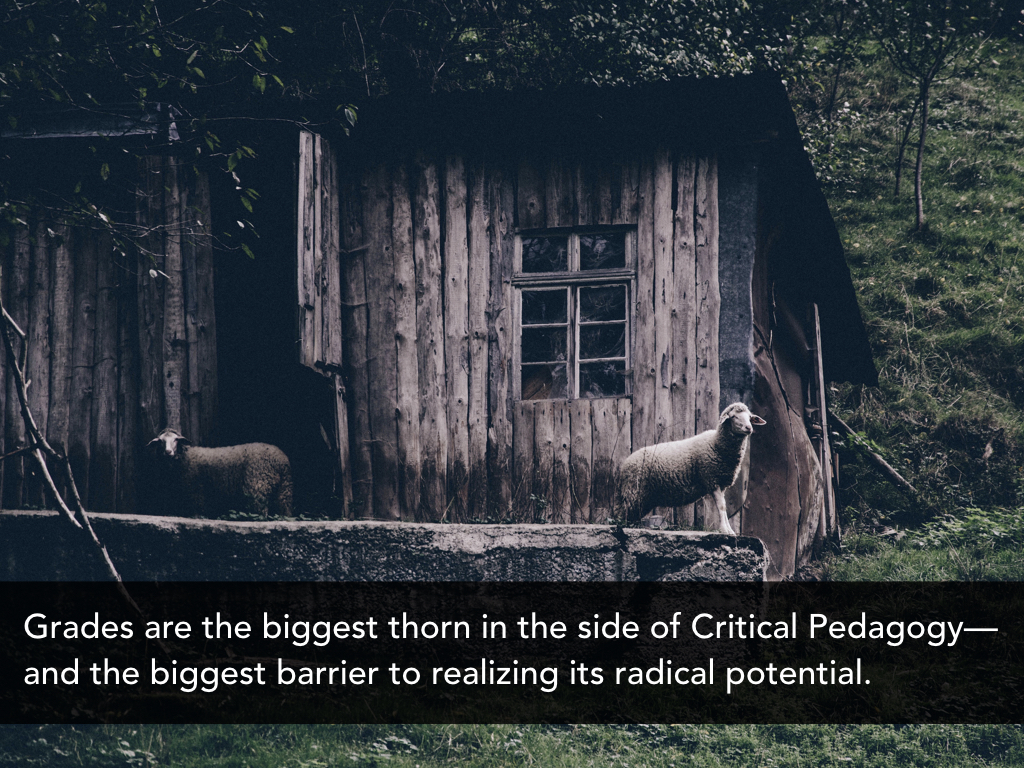
These alternative approaches can work on their own or in combination. With classes of 25 or 300. (You aren't going to write an individual letter responding to every student self-evaluation in a class of 300, but you can write a letter to the whole class, talking about the trends you notice and suggestions for moving forward.) Ultimately, any assessment strategy demands us to adapt, in the moment, as we encounter each new group of students. This attention to context, our own and our students', is what critical pedagogy calls for.
Grades are a morass education has fallen into that frustrates our ability to focus on student learning. But, if grades are going to control so many of the conversations we have in Education, at the very least can we be more creative in how we approach them?
